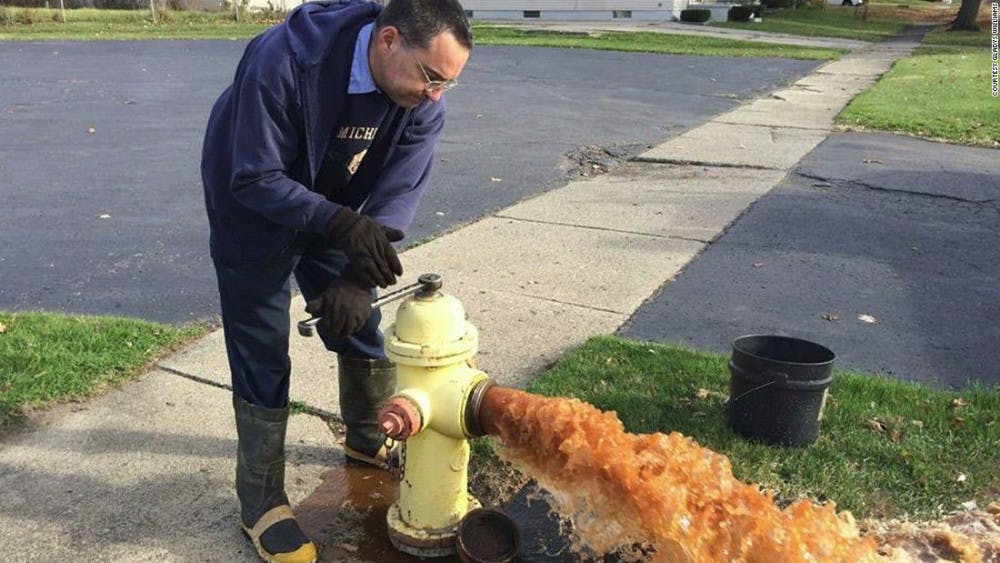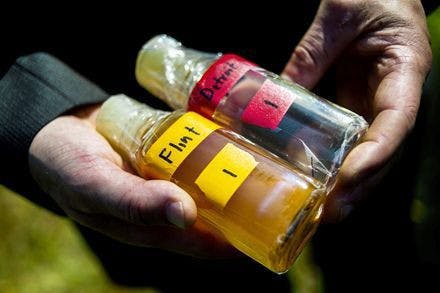
An official conducts a fire hydrant flushing to show the water contamination.
The city of Flint, Michigan changed its water source from Lake Huron to Flint River in April of 2014, beginning what's now a four year battle for Flint residents. A month later, the water coming from city taps became pungent and discolored and residents started to complain about the water quality.
Four months after changing the water source, Michigan’s Department of Environmental Quality (MDEQ) confirmed that E. coli and total coliform bacteria were in the water, leading to multiple warnings for residents to boil their water before use.
According to MDEQ, chlorine levels in the water were increased to address the problem.
Subsequently, residents were drinking water that was contaminated with lead which led to a distrust between citizens of Flint and the government.
At the peak of the water crisis, one citizen’s water was recorded to have 397 parts per billion lead compared to the federal limit of 15 parts per billion, according to Mother Jones Magazine.
On Jan. 2, 2015, Flint was found to be in violation of the Safe Drinking Water act due to high levels of trihalomethanes (TTHM), the disinfection byproducts that occur when chlorine interacts with organic matter.

Water samples from a Flint, Michigan home in 2015.
Because of this, the state started buying bottles of water for its government employees.
Flint switched back to the Detroit water supplier, the Great Lakes Water Authority, on Oct. 16, 2015; Governor Rick Snyder’s office gave a press statement saying the water would be easier to manage and that it seemed the residents of Flint would trust it more.
However, two months later, Flint Mayor Karen Weaver declared a state of emergency over the elevating lead levels in the water. A month after in Jan. 2016, Governor Snyder and President Barack Obama both declared state of emergencies as well.
Obama’s federal state of emergency declaration meant the Federal Emergency Management Agency (FEMA) was allowed to provide equipment and resources to the residents affected by the crisis, and federal funding could be implemented to help cover the cost of water.
Three weeks after states of emergency were declared, the Environmental Protection Agency (EPA) issued an emergency order on the means that the City of Flint’s and State of Michigan’s responses to the water crisis were “inadequate”, according to the EPA’s official emergency administrative order.


As of April, 2018, Michigan ended the free bottled water program that was implemented in response to the deadly levels of lead in the city’s tap. Governor Snyder said in a press statement that the water’s quality is “well within the standards” after tests were done.

The difference in water between Flint and Detroit, Michigan.
The free bottled water program was part of the $450 billion dollar federal aid package that followed after Obama declared a state of emergency; the water bottles were given out at multiple locations across the city.
Dr. Mona Hanna-Attisha, a pediatrician who was one of the first to notice the rising levels of lead in children’s blood, said in a tweet that the decision to end the program was wrong, and “until all lead pipes are replaced, state should make available bottled water and filters to Flint residents.”
This is wrong.
Until all lead pipes are replaced, state should make available bottled water and filters to Flint residents.#FlintWaterCrisis https://t.co/z1gNVaDGXS— Mona Hanna-Attisha (@MonaHannaA) April 6, 2018
Despite it being said by officials that the water is safe, residents still don’t trust the water.
The main question to gather from this article is, “Why has it taken over four years to fix this issue?”
According to Anna Clark, author of “The Poisoned City”, a lot of the problems come down to the history of Flint - segregation and unfair housing laws caused the population to be cut in half and for middle-class, white residents to leave.
Today, Flint has half the number of residents it did in the 1960s, and there’s still more infrastructure than needed for the number of residents. Because of this, Flint citizens are paying for a water system that’s meant to serve more than twice as many people.
Since it was harder for residents to afford the water, it was left stagnant and led to a large absorption of lead and corrosion of other contaminants.
The Michigan Department of Civil Rights (MDCR) panel found in a commission that institutional racism is also at fault for the crisis - their studies went back to the segregation and unfair housing laws.
These policies coincided with each other in a way that if you were an African American or an immigrant from some countries, it was nearly impossible for you to buy a home outside a few neighborhoods designated for people of color, or to attend a school that wasn’t overcrowded.
The lack of a political climate in Flint left residents nowhere to go, which also allowed the government to delay getting involved until it started making national news. Being in a low-income, low-populated area only made the circumstances worse for the residents.
It’s been easy to push the Flint water crisis under the table as it’s had a lack of media coverage since the peak of its issues. National reports were not made on the crisis until about a year after it began.
A Harvard study conducted in 2017 posed the question: Would the situation have turned out differently if national media intervened sooner?
Poor media diversity contributed to the crisis because there is not a fair representation of people of color (POC) in the media. Only 17 percent of newspaper staffs in the nation are POC, according to Harvard.
Overall, media coverage has definitely decreased, leaving the impression that the situation has been handled.
Would this crisis have kept going for four years if it happened in a predominantly white area?









